The Harpoon missile has been a mainstay of the American arsenal for the last 40 years. Launched by surface ships, aircraft, and submarines, it has also found use in land-attack versions, and continues to be modernized and upgraded today.
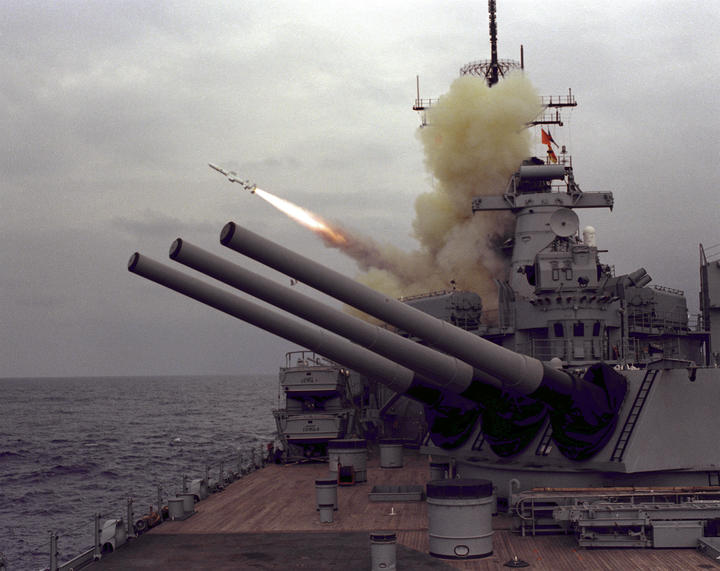
Iowa launching a Harpoon
Harpoon, technically AGM/RGM/UGM-84,1 began life in the mid-60s as a weapon for patrol aircraft to shoot at surfaced submarines.2 While submarines generally prefer to spend their time underwater, the Soviets had yet to perfect the art of the underwater missile launch, and both cruise and ballistic missile submarines would have had to surface to use their weapons. The SS-N-3 missiles that armed most of the anti-ship cruise missile submarines required midcourse guidance from their launch platform, increasing the window of vulnerability even more. But in 1967, even before a contract had been placed, the Israeli destroyer Eilat was sunk by Soviet-supplied anti-ship missiles, kicking off a mad scramble for similar weapons.
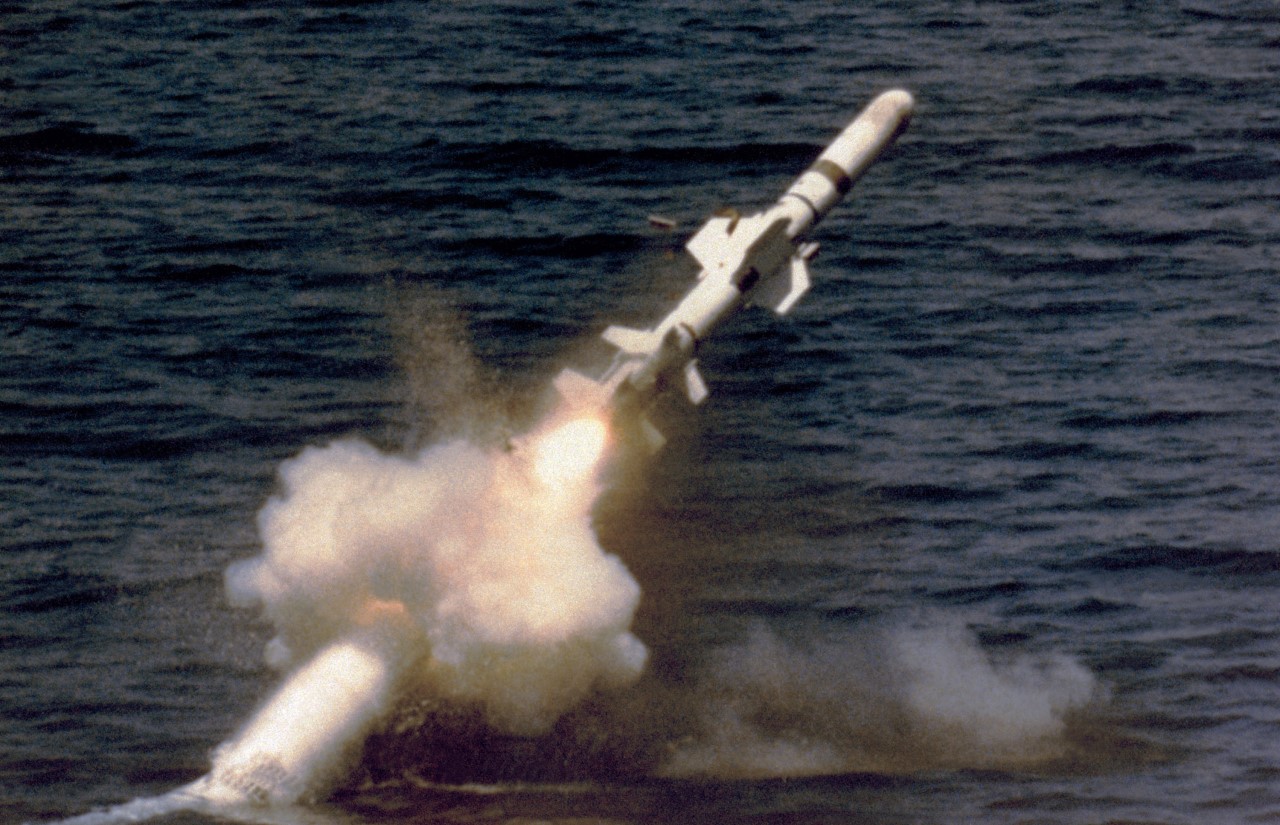
A UGM-84 is fired from its capsule
In 1971, McDonnell Douglas was issued a contract for the Harpoon missile, now intended for launch by air, surface, and sub-surface platforms. All three versions would share a common missile body, with different ancillary hardware. The range requirement was 50 nm, which meant that a turbojet would be needed instead of the rocket originally planned. For the air-launched missile, all that was needed was a simple set of lugs, but the shipboard missile would require a rocket booster and folding fins, and the submarine version had to be encapsulated with the necessary gear to allow it to be fired from a torpedo tube, float to the surface, then use a rocket booster to get airborne. Whatever its launch method, the missile would fly a series of predetermined waypoints, then switch on its radar seeker when it got close to the target's estimated position.3 The short flight time4 mitigates most of the problems of targeting moving ships and renders anything beyond the inertial/radar guidance unnecessary.
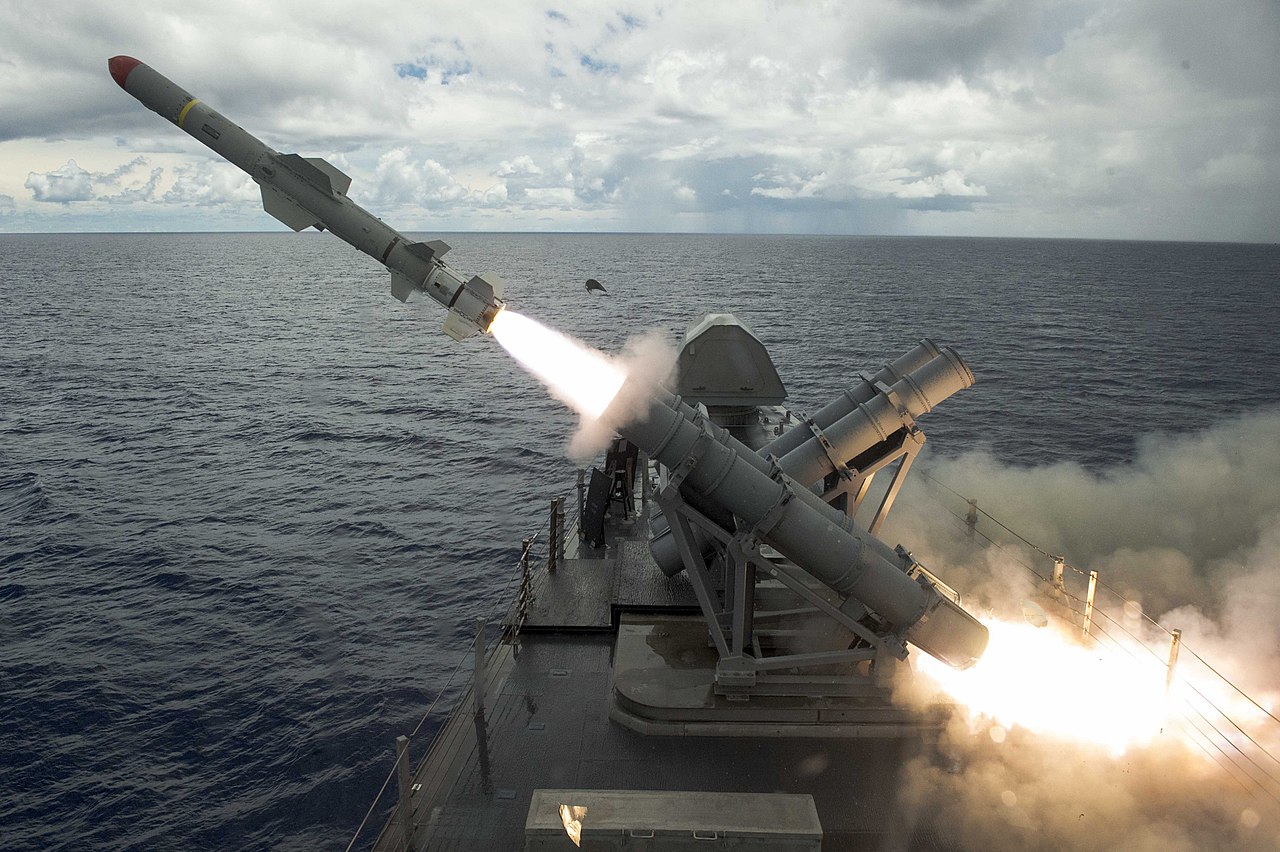
A Harpoon is launched by USS Coronado
When a target is detected, most versions of the missile have a choice between using a pop-up attack, where the missile climbs from its sea-skimming cruise to dive in on the target from above, or continuing to hug the water all the way to the target. The selection is usually based on what will most effectively deliver the 488-lb semi-armor-piercing blast warhead to the target.5 Pop-up, for instance, is ideal against submarines, which are low to the water, but could be thwarted by a carrier's armored deck.6 Unfortunately, modern warships are tough, and anything bigger than a missile boat might take more than one Harpoon to disable or sink. Estimates are that two hits should take out a frigate, four a missile cruiser, and five would be required for a Kirov.
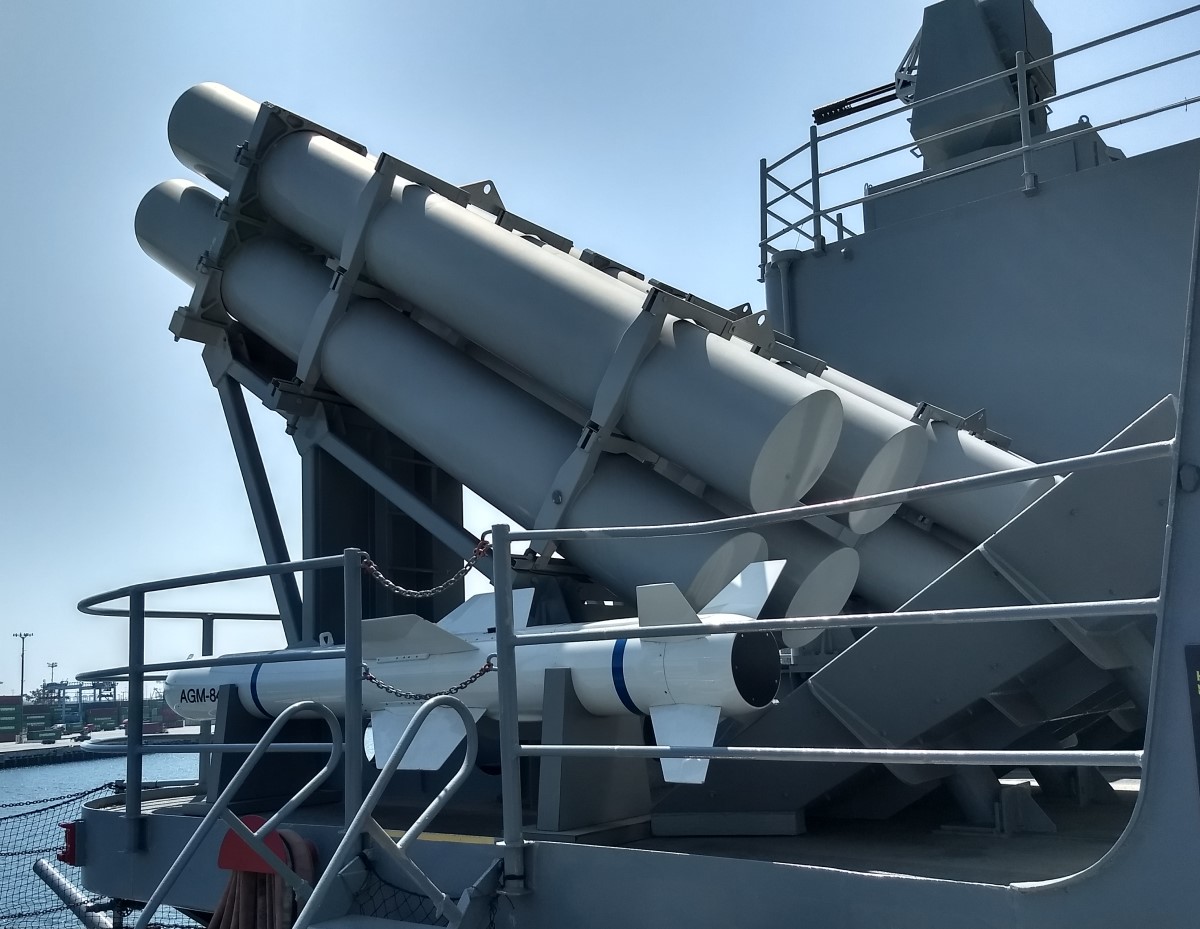
The port Harpoon quad launchers on Iowa. In the 80s reactivation, four quad launchers were fitted, 2 port and two starboard. Note the flame deflectors behind the launchers in the lower right.7
The RGM-84A first entered service in 1977, followed by the AGM-84A in 1979 and the UGM-84A two years later. Over the years, Harpoon has been upgraded with changes in technology, giving it increased range, a better radar seeker, and smarter guidance. An attempt to extend range even more produced the AGM/RGM-84F, which had an extended fuel tank for 50% more range,8 as well as the capability to fly a cloverleaf search pattern if the initial target wasn't detected. However, the end of the Cold War killed the program, and the USN instead chose to rebuild D-model missiles with F-model guidance, producing the AGM/RGM/UGM-84G.
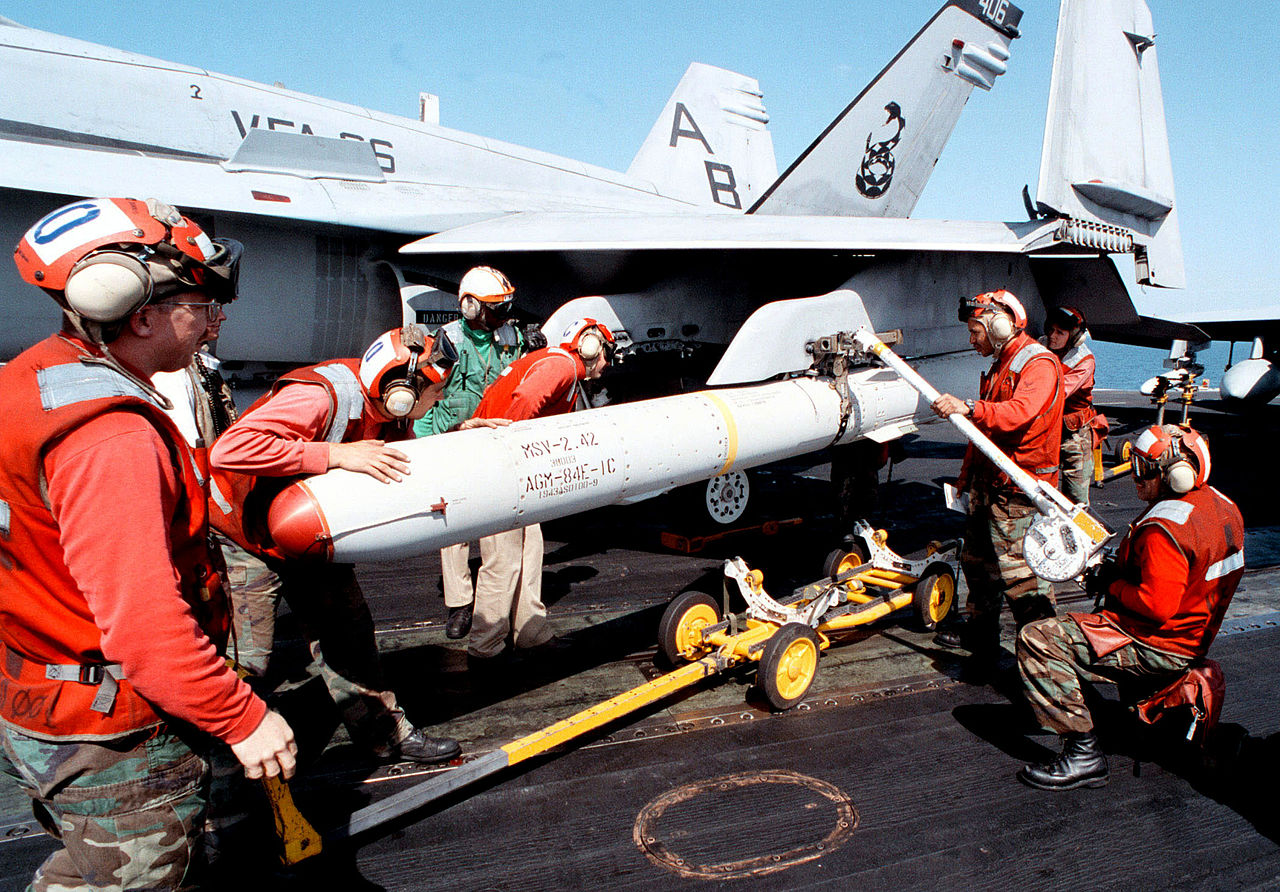
A SLAM being loaded onto an F/A-18 aboard USS George Washington9
The Harpoon family also grew outside of its traditional anti-shipping remit. In the mid-80s, the USN selected it as the basis for an interim land-attack weapon, the imaginatively-named Standoff Land Attack Missile (SLAM). This variant, known as AGM-84E, married an imaging infrared (IIR) guidance system from the Maverick missile, a datalink from the Walleye glide bomb and a GPS receiver to a Harpoon airframe, warhead, and propulsion system to produce a weapon capable of precisely striking targets from 50 nm or more away. The datalink was used to send the IIR picture back to the launching airplane about 60 seconds from impact. The pilot would designate the aimpoint for the missile, which it would automatically attack. Development took only 27 months from program start to first delivery, and a handful of SLAMs were used in Desert Storm despite the fact that it was still in operational test status.10
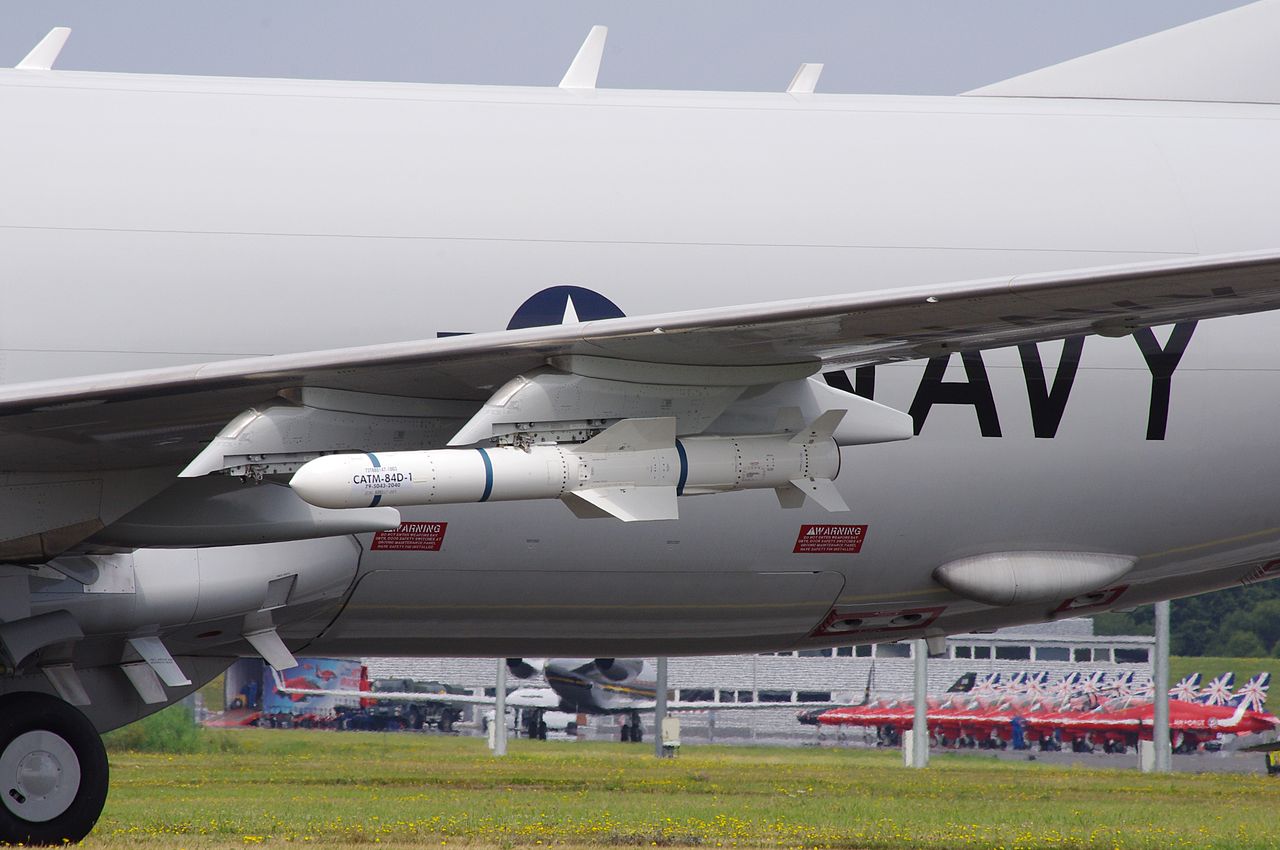
A captive-carry Harpoon under the wing of a P-8
In the 1990s, Boeing11 proposed a new variant, known as Block II. This involved major changes to the seeker and guidance unit, including a new inertial/GPS navigation system closely related to the one used by JDAM and software updates that allowed the seeker to be loaded with the local shoreline, which it would then "blank out" of the radar picture. This let the missile hit targets 90% closer to the shore than had previously been possible, a vital capability at a time when the USN was pivoting away from traditional blue-water missions and towards littoral warfare. The updates also gave it a limited land-attack capability through the use of preprogrammed waypoints. New build missiles were known as AGM/RGM-84J,12 while the L suffix was used for conversions from G models.13 More recently, a Block II+ has produced the AGM/RGM-84M, the main addition being a datalink that allows Harpoon to be remotely retargeted over the standard Link 16 network.
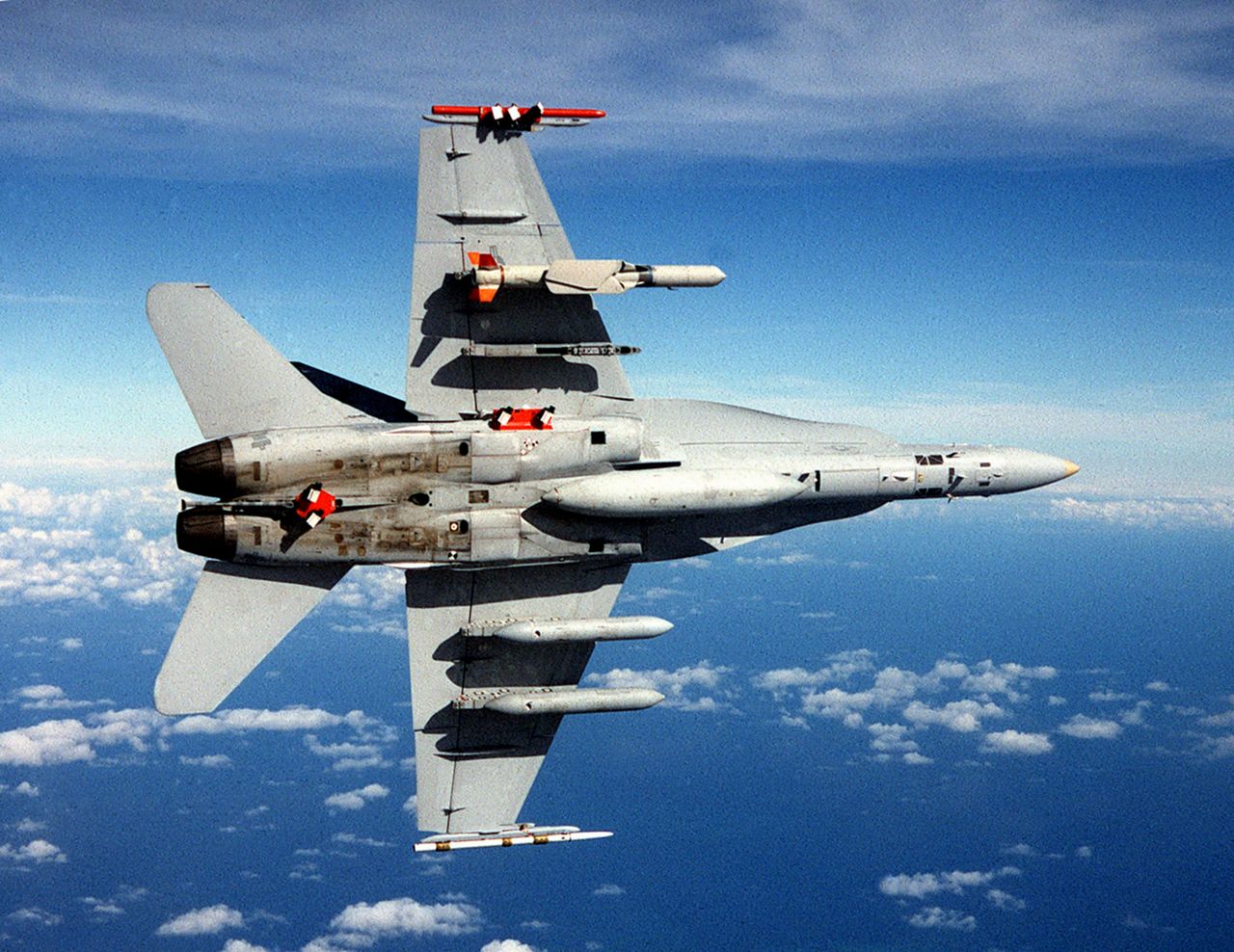
An F/A-18 carries a SLAM-ER under the right wing, and two datalink pods under the left
SLAM has also received updates over the years. The biggest drawback of the AGM-84E was its limited range, and to fix this, the missile was fitted with wings derived from those on the Tomahawk cruise missile. In many ways, it is Naval Aviation's answer to that weapon, the two missiles even sharing the same mission planning process. The result was the AGM-84H SLAM-ER (Expanded Response), with a range of 150 nm. It retains the guidance system of the original SLAM, although with a new automatic target recognition system that gives the capability for fire-and-forget operation. The warhead has also been replaced, with a titanium case to double penetration against hard targets and the missile's nose was modified for improved stealth. It was the first modern missile that could be updated in flight, a capability that several weapons now have, and software updates have even given it anti-ship capability. SLAM-ER is incredibly accurate, with a reported CEP14 of only 3m, and the AGM-84H was replaced in production by a slightly upgraded variant known as the AGM-84K, although they are functionally identical.
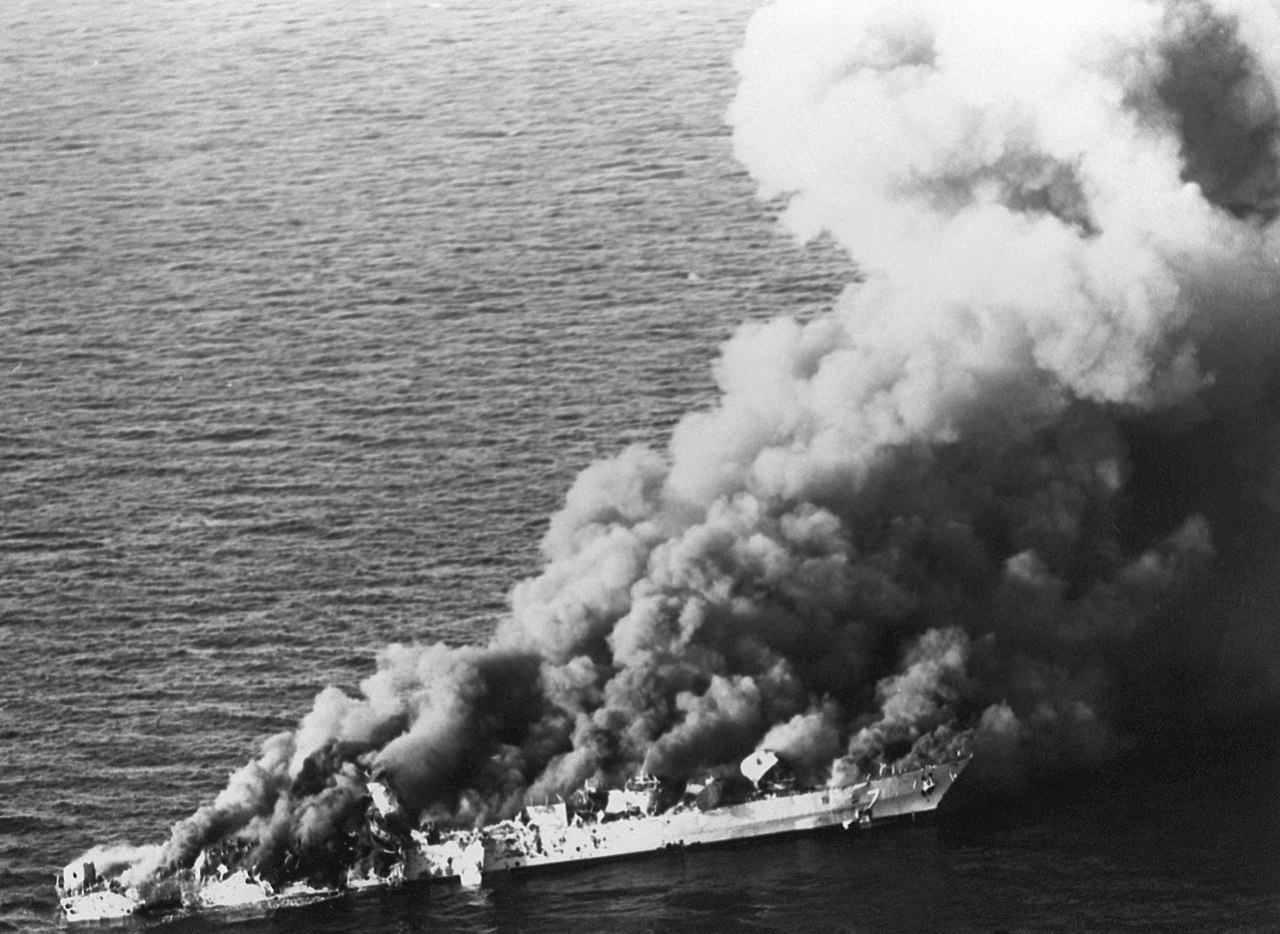
Iranian frigate Sahand burns after being hit by Harpoons
The Harpoon family has been a great success, with over 7,000 missiles produced by December 2017, about half for export customers. 30 countries, ranging from the UK to Morocco and Chile, use the anti-ship variant, while SLAM-ERs have been exported to Saudi Arabia, South Korea, Turkey and the UAE. In combat, Harpoon has generally performed well, from its first use by the Iranians in 1980,15 to its employment against Libyan patrol boats by the USN in 1986 and use by both sides during the American retaliation for the mining of the frigate Samuel B Roberts in 1988. The last combat use of Harpoon was in 1991, when a Saudi missile was used against Iraq. Today, despite all the updates, Harpoon seems to be on its way out, replaced by weapons like NSM and LRASM. It's not particularly stealthy, and there are serious questions as to its survivability against modern air defenses. As a result, the quad-pack Harpoon canisters that have so long adorned the decks of American warships are gradually being removed. But Harpoon has served well, and will remain a vital part of the American arsenal for the next decade.
1 The different codes refer to different launch platforms. AGM-84 is the air-launched version, while RGM-84 is fired by surface ships and UGM-84 by submarines. ⇑
3 There is an alternative mode, known as Bearing-Only Launch, in which the missile switches on its radar as soon as it is fired and attacks the first thing it sees on a specific bearing. This is probably an emergency mode, as it greatly increases the risk of hitting the wrong target. ⇑
4 A maximum of maybe 15 minutes at maximum range. ⇑
5 The warhead has 214 lb of explosives, and a fairly thick front to give it reasonable penetration. ⇑
6 Although the warhead is pretty large and has some AP capability, all indications are that claims of equivalent penetration to a 10" AP shell are misplaced. ⇑
7 My photo. I've just now noticed that the Harpoon missile on display is an AGM-84 instead of an RGM-84. ⇑
8 The missile, stretched 60 cm, couldn't fit into a submarine torpedo tube, so there was no UGM-84F. ⇑
9 I'm not quite sure what's going on with the fins on this missile. I suspect that the fins are detachable/retractable and are either installed or deployed after the missile is on the wing. ⇑
10 There was some investigation of a ship-launched SLAM in the early 90s, but it never got very far, presumably because it wasn't seen as necessary with Tomahawk available. ⇑
11 Boeing bought McDonnell Douglas in 1997 and took over its contracts. ⇑
12 I'm not sure any of these missiles ended up in USN service. One source indicates that the last new-build Harpoons for the USN were procured in 1991, and the missiles have been remanufactured several times since then. ⇑
13 The UGM-84 was retired in 1997, due to increasing maintenance costs and skepticism about its tactical utility. In 2019, the USN officially announced plans to put Harpoon back aboard submarines, although the timescale for this is still not clear. Other nations have continued to use UGM-84 variants throughout. ⇑
14 Circular error probable, the distance from the target which 50% of shots will land within. ⇑
15 The Shah had bought Harpoon before the Iranian revolution, and these and many other weapons were used by the new government afterwards. ⇑

Comments
If I understand correctly, the likely successor to the Harpoon is the AGM-158C LRASM. This is another turbojet-powered high-subsonic anti-ship missile; substantially heavier, with correspondingly larger warhead and longer range, but still compatible with Mk 41 VLS; and with a stealthier airframe. (It also has a new guidance system, but presumably this could be backported to the Harpoon, like so many other improvements.)
Why is it, though, that the US and allies don't seem to have any supersonic anti-ship missiles, nor any plans to produce them? The USSR had the Kh-22/AS-4, capable of Mach 4+, back in the 1960s, and Russia, India and China are still operating and developing new missiles with similar speeds (e.g. BrahMos, Hsiung Feng III, BrahMos-II, Zircon). The US must be capable of producing something similar.
Perhaps a high-speed missile has benefits for other countries that don't apply to the US, or don't apply sufficiently to compensate for the difficulty of engineering one. The most obvious benefits I can think of are that a faster missile (i) should be harder to intercept, and (ii) will arrive at the target while the targeting datum is still fresh. But I don't see why these should be dramatically less significant for the US.
Looking around a bit more, I see that Japan is developing the ramjet-powered ASM-3, capable of Mach 3+. Are there any other supersonic anti-ship missiles developed by the US or its allies that I've missed?
Finally, for anyone who (like me) was curious about the location of the air intake for the Harpoon's jet engine: it's a small inlet on the underside of the missile body.
@DampOctopus
Thank you, I was wondering about the intake (I was guessing it popped out in flight).
The greater speed might come with a shorter range, all else being equal (e.g. the original, presumably faster, rocket powered weapon). If you think you can locate targets far enough away to use the extra range, and can get the missile there before it moves too far (easier against fixed shore targets, or if you can communicate with the missile mid-flight) perhaps it's worth accepting subsonic speed. To some extent you may be able to use a low rcs to reduce the targets warning time to near that of a much faster, but less stealthy weapon.
I remember the Harpoon from my days playing the tabletop war game of the same name. Brilliant missile; not a lot of bang. Meanwhile the Russians were shipping explosives by air freight.
I expect the biggest limitation on the supersonic antiship missiles is their size. Kh-22/AS-4 has to be launched by a medium to heavy bomber, and the rest seem really big and heavy for carrier-based fighters -- twice the size and weight of Harpoon at a minimum. They're apparently still vulnerable to Aegis, and their size means putting enough in the air to seriously threaten Aegis-equipped ships requires a pretty huge air wing.
LRASM isn't really a direct Harpoon replacement. It's a substantially larger missile, designed to be used very differently. One of the things that has made Harpoon so successful is that it's small, light, cheap and easy to use. LRASM has about twice the range, and it's not a bolt-on like Harpoon. (Which has never been operationally used out of the VLS.)
Which brings us neatly to the problem with supersonic missiles. Size and cost, as Matt said. Something like a P-700 is like 15 times the size of a Harpoon. You couldn't even fire one in the weight/volume allocated to a Harpoon quad launcher, and four Harpoons are probably just as likely to get through the target's missile defenses, if not more so. Particularly because targets with poor or nonexistant missile defenses outnumber those with good defenses by a considerable margin. Even LRASM is twice the size of Harpoon, with obvious implications for number carried.
The supersonic missiles are substantially heavier, though becoming less so, which I think is associated with the shift from rockets to more-efficient ramjet propulsion. The ASM-3 is 900kg, which puts it between Harpoon and LRASM; the Kh-31 is about the same weight as Harpoon, though shorter-ranged and with less than half the warhead. I can buy that having a greater number of slower missiles is preferable, especially when each of them requires one or more (expensive!) defensive missiles to stop it.
But then why have Russia, India and China all developed supersonic anti-ship missiles? What's the difference between their anti-shipping mission and that of the US?
I'm not sure the Kh-31 is really an ASM. It looks like a high-speed land-attack missile they stuck an anti-ship seeker on. The warhead is much too light for anti-shipping work, although it's possible that they've got it fuzed to do damage topside, which could be quite effective.
Who they expect to be fighting. Russia and China are aimed at the US, while I assume India is aimed at China. Until very recently, there was really nobody around who merited a better ASM than Harpoon, at least not enough to be worth spending the money to build one. That's changing, as we see with LRASM.
Also, it's worth pointing out that most SAMs have a secondary anti-ship capability, although usually not over the horizon. So for a long time, the primary backup to Harpoon has been Standard.
Can ESSM be used against surface targets too? Might be useful against small boats, filling the same sort of role as the Hellfires on the LCS. Also, isn't the Joint Strike Missile kind of a Harpoon replacement? Or is closer to its predecessor, the Penguin?
Oh, and have a happy Thanksgiving Ü
I believe ESSM has an anti-surface mode, yes. But it's a 640 lb missile with an 86 lb warhead, while Hellfire is a ~100 lb missile with a ~20 lb warhead. So ESSM is going to be a lot more lethal against big targets. JSM is essentially a Hellfire with a different seeker, and fills the same niche as Hellfire. There's not really a Penguin successor per se. NSM is going on surface craft, and is probably the closest to a Harpoon successor, but I don't think it's going on American helicopters.
I thought it was quite a bit more capable, but if JSM/NSM is very similar to Hellfire, and American helicopters already have Hellfire, then I can see why you wouldn't bother buying it for them too.
Oh, oops. I got the JSM confused with the JAGM. (This is why we use memorable names!). NSM is more or less a harpoon successor, although it's a bit lighter.
@bean
I'm still missing something here. If Russia and China developed supersonic ASMs to fight the USN, that implies that supersonic ASMs are the weapon of choice against modern naval air-defence systems. China is rapidly developing such systems, and seems to be the USN's most obvious opponent, so I'd expect the US to develop a similar weapon. Note that India has also developed supersonic ASMs which are, as you say, probably aimed at China.
Maybe I'm wrong, and the Chinese navy isn't actually a likely opponent for the USN? Or perhaps slow, stealthy ASMs (like LRASM) are preferable to supersonic ASMs, but China/India/Russia lack the technology to produce something that stealthy?
And yes, I take the point about SAMs having a secondary anti-ship mode. Being faster and more maneuverable, they're presumably much harder to intercept. I imagine there's a mode of engagement in which dual-purpose SAMs first do topside damage to cripple the enemy defences, followed by heavy ASMs to actually sink the target - somewhat like pre-Dreadnaught tactics with QF and heavy guns.
I think the explanation for LRASM is more straightforward. Developing a new super/hypersonic ASM is going to cost a lot of money and take a long time, particularly when done to US standards. China wasn't a huge threat a decade ago, and all the money was going to the Middle East, so we didn't buy one then. LRASM, being based on an existing missile, was a lot faster and cheaper to develop. That said, slower missiles can fly lower and have a lot more options for maneuver, and I'm sure LRASM uses these to the hilt.
As for using SAMs as the equivalent of QF guns, the dichotomy doesn't really exist today in the same way. Modern warships are too dependent on their electronics to be able to survive something like that with any sort of combat-effectiveness. Also, they aren't armored, and SAM warheads could easily tear up flooding paths. Continuous-rod warheads are particularly nasty things, and a perforated bulkhead is hard to patch.
Worth noting that a couple of old-style Sea Sparrows were enough to mission-kill a Turkish frigate, and render it a total constructive loss, even though one of the warheads was a dud. ESSM explicitly retains the ability to engage surface targets, and now has enough range to reach the radar horizon. And is no longer limited to 1-2 missiles per fire control radar.
I suspect that an engagement between modern surface combatants within their effective radar horizon will be won by whoever A: shoots first or B: has missile defenses that can reliably defeat small supersonic targets on less than ten seconds' notice. And I'm not optimistic about the latter.
The winning move is probably to have one of your helicopters pinpoint the other guy's surface combatants before they come over the horizon. But that works best if you have OTH-capable antiship missiles that can penetrate enemy missile defenses; by choosing the relatively large, expensive, and slow LRASM, the USN is betting everything on its stealthiness being able to overcome modern missile defenses. Or on always having a working aircraft carrier available.
So if you are fighting within radar range, presumably a faster missile is better, as it would be more likely to reach its target before they could launch in return. If you have a helicopter or similar to spot for you then maybe speed isn't so vital? And if you compromise on speed, the missile could be smaller, or longer ranged, or carry a greater payload, or some combination. So if I've got that right, could it be that the US is just more confident about getting data from aircraft? Or am I overthinking things?
First, speed is also helpful in evading defenses. We'll probably only find the balance between that and LRASM's stealth if we ever end up with said missiles being used in anger, and I pray it never comes to that. Second, a helicopter is kind of short-legged for spotting. The Soviets used modified Tu-95 Bears for the job, along with satellite data. I'm sure the detailed kill chain for LRASM is classified.
How easy is it to test CIWS against anti-ship missiles? You can presumably fit decoys like chaff rockets to an expendable target, but risking more sophisticated and expensive systems (to say nothing of crew) can't be practical given the damage even an unarmed missile can cause with the force of its impact, and any remaining fuel. I suppose anything with the range of ESSM could be fired from a separate ship to the target, as long as you were confident that the missile would go for the correct vessel.
Do the Burkes carry something like the Blackjack (RQ-21, not TU-160)? I could imagine they might help with spotting, though I don't know if communicating with it might risk giving away your own position.
If you have fixed-wing aircraft to do your reconnaissance, then you've probably got fixed-wing aircraft to deliver large salvos of air-to-surface standoff missiles. And I'm guessing the USN's plan A, B, and C all involve aircraft carriers. Plan D is the submarine community getting a word in edgewise and saying the SSNs will take care of everything. Surface-launched LRASM is a hedge against people laughing at the Navy because their destroyers can't destroy enemy ships any more, so what's the cheapest way to put a credible post-Harpoon antiship missile on them. Given that air-launched LRASM was already going to exist (because see plans A, B, and C), that was the way to go.
It is bigger than it ought to be if it were designed for the role, and it does bet everything on stealth trumping all defenses. But the marginal cost of strapping a booster onto an existing missile, doing some integration tests, and buying half a dozen or so for every destroyer, beats any new-missile development program.
On the subject of testing, this indicates the Navy still uses towed targets for testing and training exercises involving CIWS; a “drone” on a 12,000 foot cable behind (I’m guessing) an F-18. Makes sense; the pilot can be trusted to fly a safe course where the target will pass safely clear of the ship, and the cable length is sufficient that an observer on the ship can eyeball the gun mount and verify that it’s not firing anywhere near the manned aircraft.
But that’s limited to subsonic testing. Supersonic targets would need to be autonomous, and there have been problems using those near manned warships. The USN doesn’t do that any more, but does have a single remote-controlled target ship that can be fitted with various missile-defense systems and targeted with whatever sort of drone they want - programmed with enough of an offset to miss, but if it doesn’t it just wrecks and old destroyer and doesn’t hurt anyone.
The obvious way to do the test is to mount the CIWS on a barge or something and shoot the drone past it (or use the SSSDTS). CIWS is really easy to integrate, so you're not putting that much at risk.
@John
I'm not actually sure if VL-LRASM is even still a thing. Reports of it seem to have died off a couple years ago, while we have EOC on both the B-1 and F/A-18 in the last year.
It wouldn't surprise me to see VL-LRASM vanish - the use case for it is pretty narrow, I figure. For most any planned attack case, it'll be just as easy to use aircraft. Surface-launched is mostly useful for the case where a nearby contact unexpectedly goes hostile, and for that case, SM6 is probably plenty good enough.
The Navy does frequently deploy destroyers and even cruisers outside of CVBGs. And they haven't officially announced that it is official doctrine to always run away as soon as the carrier is mission-killed. So there's also a use case where there are unambiguously hostile surface targets somewhere over the horizon, and no airplanes to go out and sink them before they cross the horizon (or get one of their own helicopters in position to coordinate an OTH missile attack).
They seem to have decided to fill that use case using bombers. Note that the B-1 got the missile ahead of the Super Hornet, and there's talk of integrating it on the B-52, too.
And SM6 can be used over the horizon too - indeed, that was part of the reason it has an active seeker, for engaging air targets before they come over the horizon. (I heard scuttlebutt from FCs when I was still in that the IR seeker on SM2 Block IIIb could do the same thing if your fix was good enough, too, but I'm less confident of that.)
I think it's short-sighted too, but I bet that's what Big Navy is thinking - for all the cases where we can plan, air-launched is good enough, for all the rest, there's Standard. That said, I'm not entirely sure how much damage Standard would actually do. There's a video out there purporting to be a Dutch warship firing an SM2 at a surface target, and the hit looks more impressive than most Harpoon and Exocet impacts, but that doesn't necessarily mean anything, and most of the visible impact is kinetic anyway. (And there, I have no trouble believing that a Mach 3 Standard packs more kinetic energy than a Mach 0.8 Exocet.)